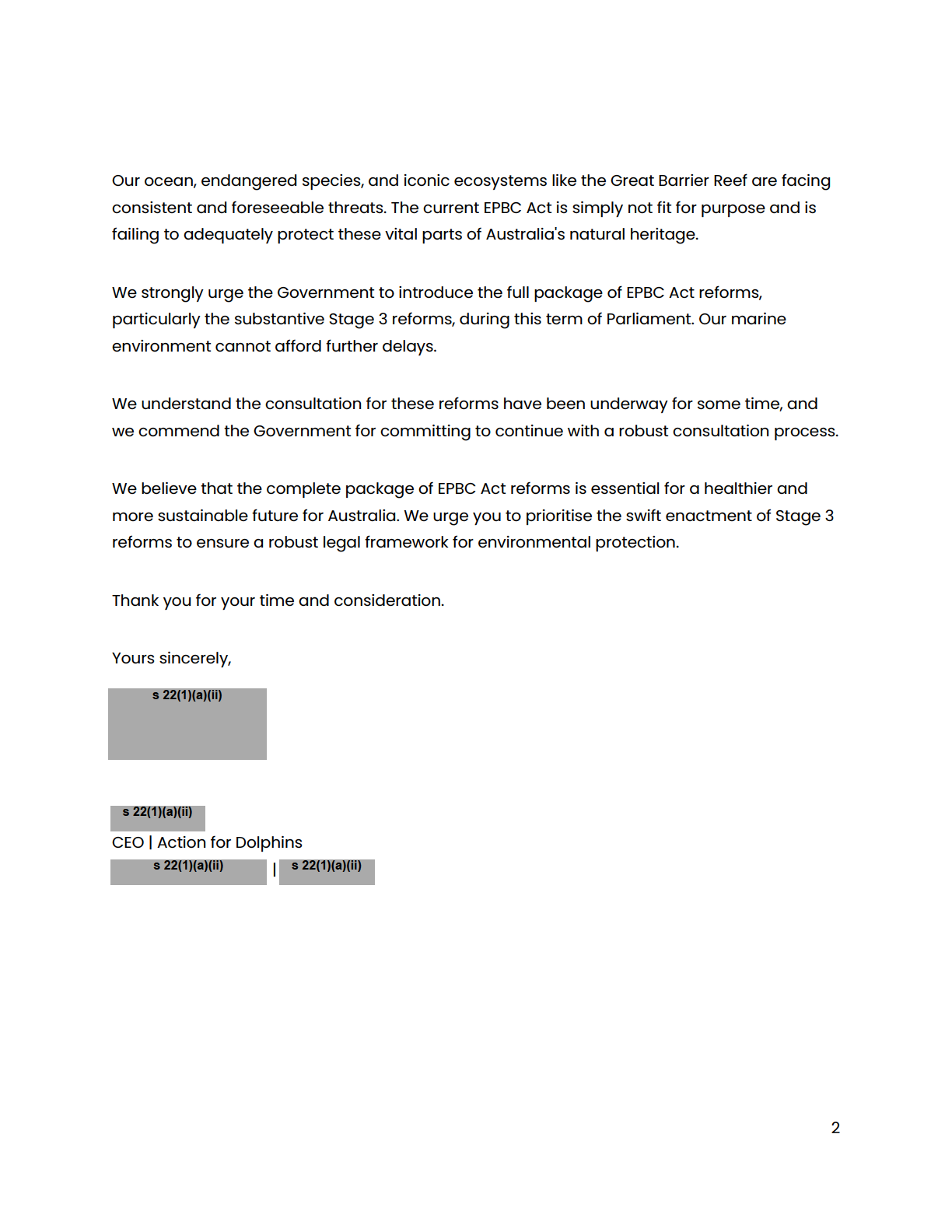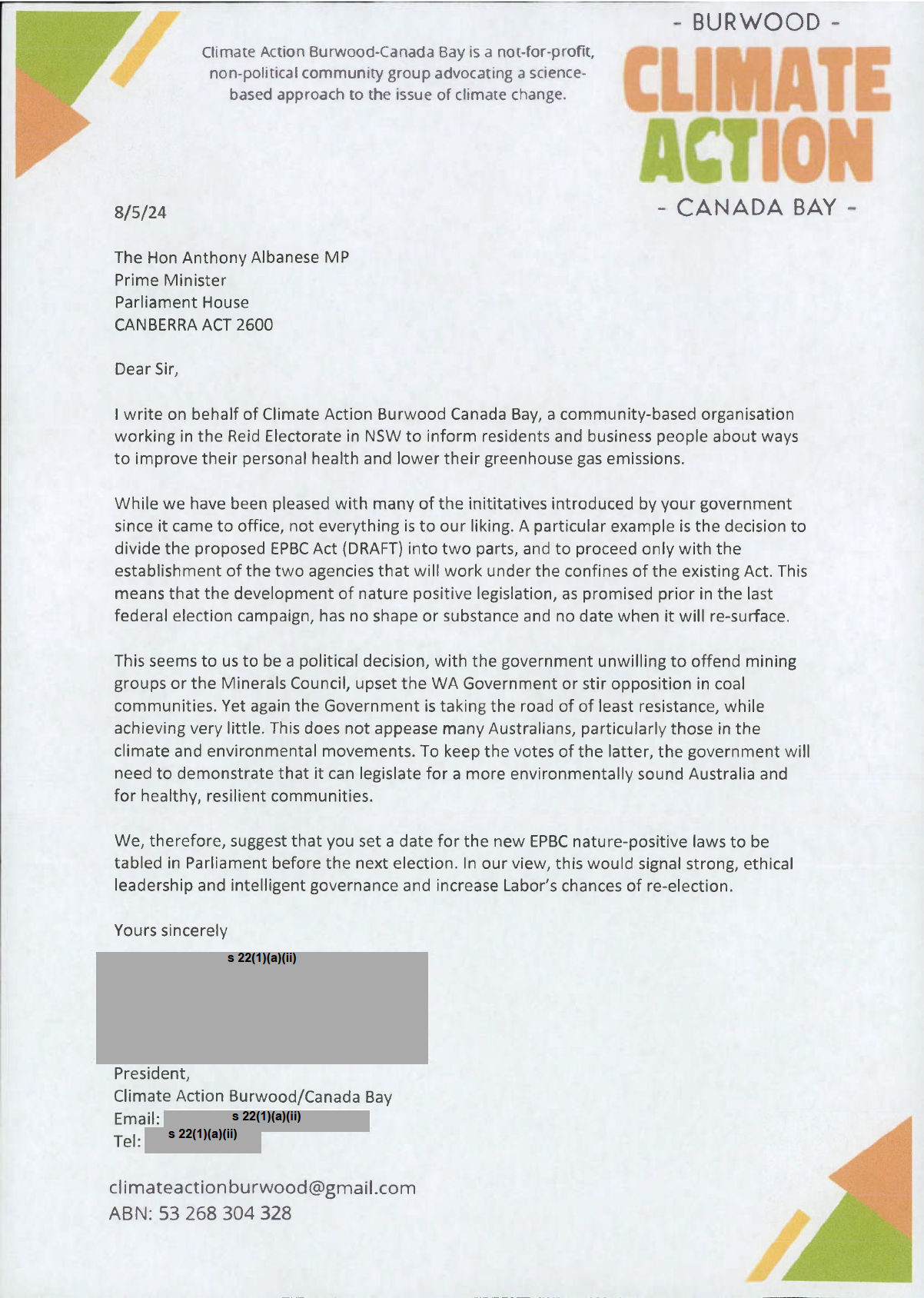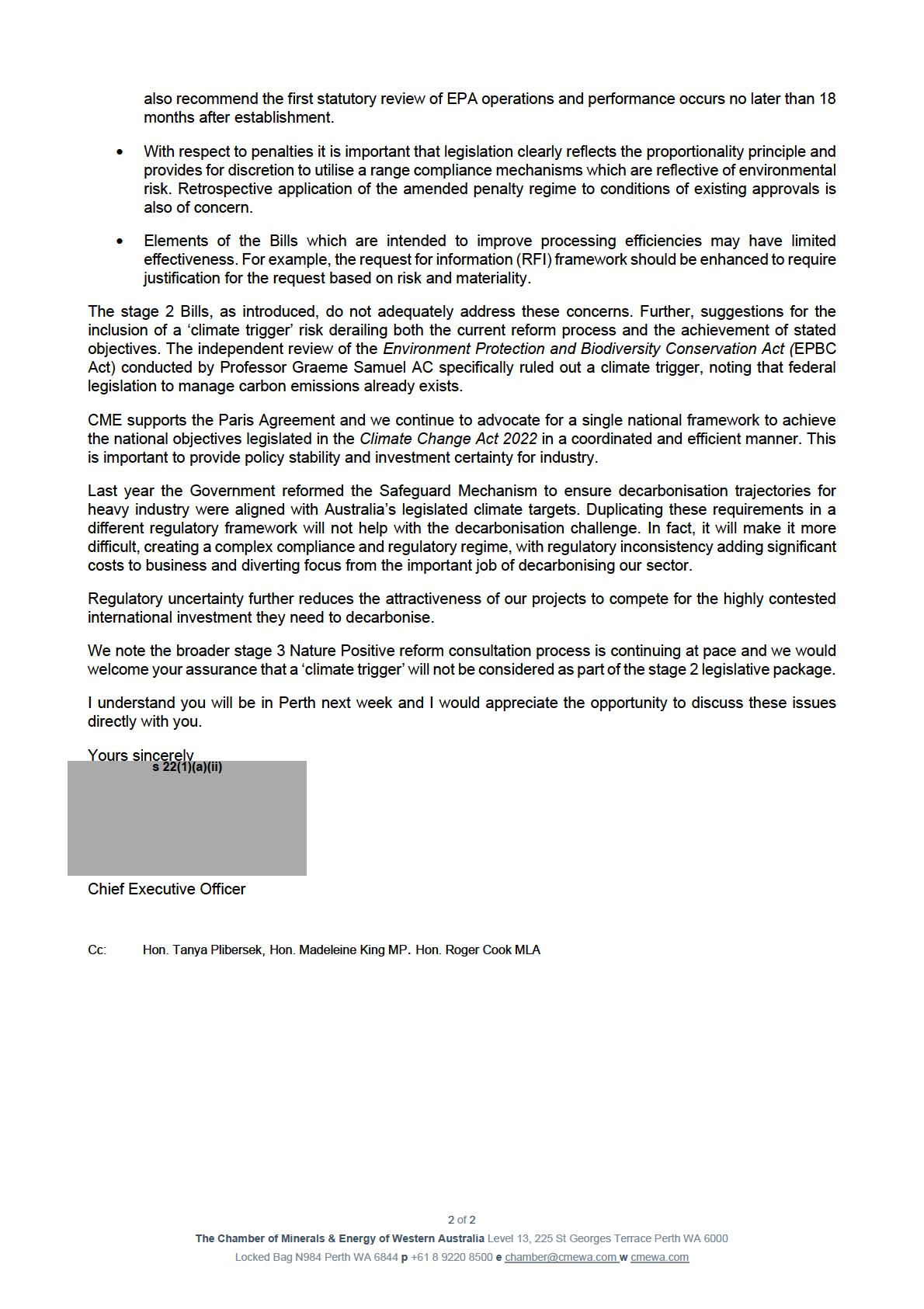
22 April 2024
The Hon Anthony Albanese MP
Prime Minister
Parliament House
CANBERRA ACT 2600
The Hon Tanya Plibersek MP
Minister for the Environment and Water
House of Representatives
Parliament House
CANBERRA ACT 2600
By email:
s 22(1)(a)(ii)
Dear Prime Minister and Minister Plibersek
Securing strong nature laws this term
Action for Dolphins is a charity dedicated to the conservation of marine life and the
protection of the ocean. I am writing to you on behalf of Action for Dolphins and 4,245 people
who have signed a petition urging the Australian Government to commit to introducing the
full package of the Nature Positive plan reforms this term.
We commend Minister Plibersek’s announcement to progress stage 2 of the Nature Positive
Plan, including the establishment of Environment Protection Australia, the creation of
Environment Information Australia and investing nearly $100 million to assist with the
efficiency of the environmental approval process. These are positive steps towards a more
robust environmental protection framework.
However, we are deeply concerned about the delay in enacting Stage 3 of the Environment
Protection and Biodiversity Conservation Act (EPBC) reforms. The Samuel Review highlighted
the urgent need for a complete overhaul of Australia's environmental laws, and we believe
that delaying Stage 3 weakens the overall impact of these reforms.
1



30 April 2024
The Hon. Anthony Albanese MP
Prime Minister
Via Email
CC: The Hon. Tanya Plibersek MP, Minister for the Environment and Water
Dear Prime Minister,
Australia’s Great Barrier Reef is in grave danger due to repeated severe bleaching events
driven by climate pollution, with not enough time to recover in the gaps between events.
This is the worst heat stress event for the Great Barrier Reef on record, which is undergoing
widespread and severe bleaching as a result.
This is the fifth mass bleaching event in nine years. Previous mass bleaching events on the
Great Barrier Reef occurred in 1998, 2002, 2016, 2017, 2020, and 2022. All were due to
unprecedented heat stress caused by climate change.
Since the last mass bleaching in 2022, at least five coal and gas projects have been approved by
the Labor Government under Australia’s outdated national environment law: the EPBC Act.
Unfortunately, instead of the progress we were promised when the overhaul of this Act was
announced, we now have no clear timeline of when this will occur.
Australia’s new national nature protection laws must be delivered before the end of this term.
And they must include a clear requirement to assess whether projects will cause more climate
harm for nature as part of the assessment process. Given the damage climate change does to
nature, it would be reckless to do otherwise.
There is strong scientific, community and parliamentary support for the Albanese government
to thoroughly embed climate change considerations into the new laws.
Australia is the world's third largest fossil fuel exporter. Climate change is global, so no matter
where in the world Australia’s coal and gas exports are burnt, they damage nature here at
home, which is precisely why our nature laws must consider potential climate impacts,
including direct and downstream pollution.
Australians understand the Great Barrier Reef is irreplaceable and want to protect it so all
generations can experience its wonder and beauty.
We urge the government to heed the science, listen to the Australian community and commit
to working with the Parliament to close the climate gap in our national nature laws.
Signed,
●
s 22(1)(a)(ii)
●
●
●
●
●
●
●
●
●
●
●
●
●



Contact:
s 22(1)(a)(ii)
CEO, Vets for Climate Action
E:
s 22(1)(a)(ii)
M:
s 22(1)(a)(ii)
The Hon Anthony Albanese MP
Prime Minister of Australia
Parliament House
CANBERRA ACT 2600
Cc: The Hon Tanya Plibersek MP, Minister for the Environment and Water
05 June 2024
Dear Prime Minister
As veterinary professionals and animal carers, we write to you on this World Environment Day
because we are concerned about the impact of climate change on the health and welfare of
our unique animals.
Our current national environment laws (the
Environmental Protection and Biodiversity
Conservation Act
1999) are out of date, and no longer able to provide the protection that our
wildlife, and the habitats they live in, require to keep them safe and healthy on a rapidly
heating planet. These laws are currently under review, and we are calling for them to be
immediately strengthened. Our unique animals and ecosystems are under threat.
Australia is home to between 600,000 - 700,000 species, many of which are found nowhere
else in the world. About 84% of our plants, 83% of mammals, and 45% of birds are only found
in Australia.
But Australia also has the unenviable record of the worst mammal extinction rate in the world.
For example, the Bramble Cay melomys, a small rodent in the Torres Strait Islands, is the first
mammal to become extinct explicitly due to climate change, and 78 species in NSW alone
have been declared extinct since European settlement.
With over 2,200 ecological communities, plants, and animal species on the Government’s
threatened species list nationally, it is urgent that the Federal Government deliver on its
commitment to prioritise strong, new nature protection laws this year.
1
We commend the Government’s introduction of an Environment Protection Australia (EPA)
and Environment Information Australia, and the focus on compliance and enforcement of our
existing nature laws. These are very necessary and long overdue. However, they are not
enough.
We are urgently calling on the Government to introduce a comprehensive package of nature
law reforms to protect our unique wildlife and their habitats.
This must include:
● Climate change to be made a ‘Matter of National Environmental Significance’
● Mandatory consideration of climate impacts in project assessments
● EPA assessment of projects to include total CO2 and other climate pollutants, and take
account of the estimated cumulative emissions
● Strong and enforceable National Environmental Standards
● The national environment law should be explicitly linked to other Australian
Government climate priorities and commitments, including the Paris Agreement,
Safeguard Mechanism, and national
Climate Change Act.
These changes are vital to ensure that our national environment laws “better protect nature,
and that we are invested to protect our precious plants and animals.”1 We ask that they are
implemented in full as soon as possible.
We would be happy to meet with you to discuss any of these issues further.
On behalf of the animals we love and care for,
s 22(1)(a)(ii)
s 22(1)(a)(ii)
s 22(1)(a)(ii)
s 22(1)(a)(ii)
s 22(1)(a)(ii)
s 22(1)(a)(ii)
s 22(1)(a)(ii)
s 22(1)(a)(ii)
s 22(1)(a)(ii)
s 22(1)(a)(ii)
s 22(1)(a)(ii)
s 22(1)(a)(ii)
s 22(1)(a)(ii)
s 22(1)(a)(ii)
s 22(1)(a)(ii)
s 22(1)(a)(ii)
1 Minister Plibersek, Press Conference, Taronga Zoo, NSW, 22 May 2024
2
 ABOUT VETS FOR CLIMATE ACTION
ABOUT VETS FOR CLIMATE ACTION
Caring for animals means caring for the climate.
Vets for Climate Action represents vets, vet nurses, vet receptionists, vet techs, animal
carers, pet owners and animal lovers. We are united by our concern by the impact climate
change is already having on the animals we love: our pets, wildlife and livestock.
From days of extreme heat, longer bushfire seasons, floods and intense storms, increased
risk of disease - our animals are feeling the effects most strongly but hold no responsibility for
the problem.
At Vets for Climate Action, we are working to inspire and educate both within the veterinary
profession and beyond, to the wider community.
We are working to protect biodiversity and recognise that the health of people, animals and
the environment are interconnected in line with the One Health concept.
We are advocating for immediate action on climate change - we want strong policy and strong
leadership - across all levels of government, from industry and across our profession to
enable a world where animals and people thrive in a healthy climate.
We are working together to promote sustainable veterinary care with our world-first Climate
Care Program: an innovative, world-first management tool designed to reduce greenhouse
gas emissions and increase sustainability in veterinary practice.
AUSTRALIAN ANIMALS SUFFER AND DIE DUE TO CLIMATE CHANGE
An Australian rodent in the Torres Strait Islands, the Bramble Cay melomys, is the first
mammal to become extinct due to climate change. Rising sea levels and storm surges resulted in
loss of habitat.
During the migratory season of 2023 thousands of
seabird deaths were reported along the Australian
coast. The scientific community is seeing a correlation with marine heat waves caused by climate
change2.
The declining sea ice between 2018 and 2022 caused by climate change is responsible for the
complete and catastrophic loss of all emperor penguin chicks from 4 out of 5 colonies in
Antarctica in the spring of 2022.
Numbats are becoming prone to overheating – reaching a body temperature greater than 40°C within
as little as ten minutes of activity in the sun, despite using techniques such as raising or flattening their
fur to regulate body temperature.3
Coral on the Great Barrier Reef has been killed by successive mass bleaching events due to
rising ocean temperatures. This brings long term risks not only to the reef itself but to the diversity of
marine fauna living within the reef, including dugong and marine turtles.
Green turtles are at risk of extinction as their gender ratio becomes distorted.4 The sex of a sea
turtle is determined by the temperature of the sand incubating the eggs. Warmer temperatures of 29.1
degrees Celsius and above produce females and cooler temperatures produce males. Global warming
means more females are born, disrupting the natural gender ratio. It is possible that sea turtle
hatchlings could be completely female in the near future.
Over 3 billion animals died or were displaced during the 2019-2020 bushfires:
○
143 million mammals;
○
2.46 billion reptiles;
○
180 million birds; and
○
51 million frogs.5
‘This ranks as one of the worst wildlife disasters in modern history,’ reported the WWF.
More than 23,000 spectacled flying foxes were killed6 in far north Queensland, when temperatures
were over 42°C, equating to almost one in every three individual animals in the population, which is
listed as endangered under the EPBC Act.
2
https://www.australiangeographic.com.au/topics/science-environment/2023/11/why-are-we-seeing-so-many-seab
ird-wrecks/
3 https://www.australiangeographic.com.au/news/2024/01/too-hot-to-handle
4 Craig Welch,
Rising Temperatures Cause Sea Turtles to turn Female, National Geographic, 9 Jan 2018, access 28 October
2022.
5 p. 2,
Interim Report: Australia’s 2019-2020 Bushfires: The Wildlife Toll, WWF, 28 July 2020, accessed 28 October 2022.
6 Sharnie Kim & Adam Stephen,
Extreme heat wipes out almost one third of Australia’s spectacled flying fox population, ABC
News, 19 Dec 2018, accessed 28 October 2022.
4
127 ringtail possums died7 after they became so dehydrated they drank sea water after 4 days of
temperatures in the high 30s, in the Mornington Peninsula, Victoria in early 2019.
Floods in Far North Queensland killed over 600,000 cattle in 2019.8 Those that didn’t drown died
of cold exposure in the summer month of February. The damage bill was estimated at $2 billion.
Flooding in NSW and southern Queensland in 2022 affected an estimated 475,000 cattle (or
about 2% of the national herd).9 It also impacted food and feed crops.
Severe flooding in eastern Australia in 2022 trapped and drowned wombats and echidnas (and
other burrowing animals) in their burrows. An estimated 475,000 grazing animals
(or about 2% of the
national herd)10 were swept away or starved when dirty water contaminated their pastures. It also
impacted food and feed crops. Even marine species, turtles and seabirds were displaced when
floodwaters reached the ocean.
Dogs or other pets can develop severe heat stress, brain damage and die in as little as 4 to 6
minutes if left unattended in a vehicle. The risks of this are increasing with more heat waves, as is the
probability of dogs burning their footpads when walking, as roads and footpaths heat up so much more
than the air.
A United Nations report has determined that about one million animal and plant species are threatened
with extinction, many within decades, more than ever before in human history. Biodiversity is essential
for the processes that support all life on Earth, including human life. An average 69% decline in
monitored wildlife populations has been recorded around the world between 1970 and 2018.11
7 Lisa Cox, ‘Falling out of tree’:dozens of dead possums blamed on extreme heat stress
, The Guardian, 7 March 2019,
accessed 28 October 2022.
8 Tom Major,
Cattle, infrastructure losses following Queensland floods could near $2b, farm lobby says, ABC News, 16 April
2019, accessed 28 October 2022.
9 Natasha May,
Floods and livestock losses leave NSW and Queensland farmers reeling from third disaster in three years,
The Guardian, 2 March 2022, accessed 28 October 2022.
10 Natasha May,
Floods and livestock losses leave NSW and Queensland farmers reeling from third disaster in three years,
The Guardian, 2 March 2022, accessed 28 October 2022.
11 UN report on biodiversity loss
5


14 June 2024
Hon Anthony Albanese MP
Prime Minister
PO Box 6022
House of Representatives
Parliament House
Canberra ACT 2600
Dear Prime Minister
STAGE 2 NATURE POSITIVE LEGISLATION
As the peak representative body for the resources sector in Western Australia, the Chamber of Minerals and
Energy of Western Australia (CME) wishes to raise concerns regarding the Government’s approach to the
Nature Positive reforms and specifically the three Nature Positive Bills1 which are currently before the
Parliament.
The proposed reforms have a direct and significant relevance within Western Australia, noting Western
Australian projects make up 72 per cent of Australia’s committed resources projects by value at $55.9 bil ion.
In 2022-23, the Western Australian resources sector accounted for 64 per cent of Australia’s resources
exports, half of Australia’s resources capital expenditure and 53 per cent of Australian resources employment.
Additionally, Western Australia hosts the largest number of existing and proposed hydrogen projects and over
half of Australia’s major critical minerals projects, with a third of this investment pipeline’s value attributable to
our members.
CME and our members are in full support of reforms that improve environmental outcomes across the economy
whilst delivering processing efficiencies. But we can only hope to achieve these outcomes if industry is
provided the opportunity to review and test the reforms, and there is the wil ingness to make adjustments
where required.
It is disappointing the stage 2 Nature Positive Bills were not released for public consultation prior to introduction
into Parliament and we request that the Regulatory Impact Assessment referred to in the Explanatory
Memorandum is released.
As we have articulated through the closed consultation process to date, CME and our members feel it is critical
that the assessment of proposed development projects is guided by the principles of ecological y sustainable
development (ESD) and that ultimate responsibility for the balanced application of these principles, particularly
for complex, national y significant projects, properly rests with the elected Government of the day.
CME members are concerned an eroding of these principles is already being observed and could be
compounded if the broad and significant changes proposed under the Nature Positive reforms are not subject
to proper review and testing. Unworkable settings risk causing further project delays and uncertainty, making
it harder to deliver projects in Western Australia and negatively impacting the viability of the projects required
to support our domestic and global energy transition and our economy.
In the lead up to the introduction of the stage 2 Bills, CME wrote to the Minister for Environment and Water
urging additional consultation and highlighting industry’s strong preference that the EPA’s function be limited
to compliance and auditing. In summary, key issues and recommendations we have raised include:
• It is important that the Government retains the ability to set clear expectations and that the EPA
operates consistently with the Government’s priorities and policy objectives. Appropriate checks on
independence are required to provide certainty for proponents and ensure a focus on outcomes. We
1 Nature Positive (Environment Information Australia) Bil 2024 (EIA Bil ); Nature Positive (Environment Protection Australia) Bil 2024
(EPA Bill); and Nature Positive (Environment Law Amendments and Transitional Provisions) Bil 2024 (Transition Bil ).
The Chamber of Minerals & Energy of Western Australia Level 13, 225 St Georges Terrace Perth WA 6000
Locked Bag N984 Perth WA 6844
p +61 8 9220 8500
e xxxxxxx@xxxxx.xxx
w cmewa.com











